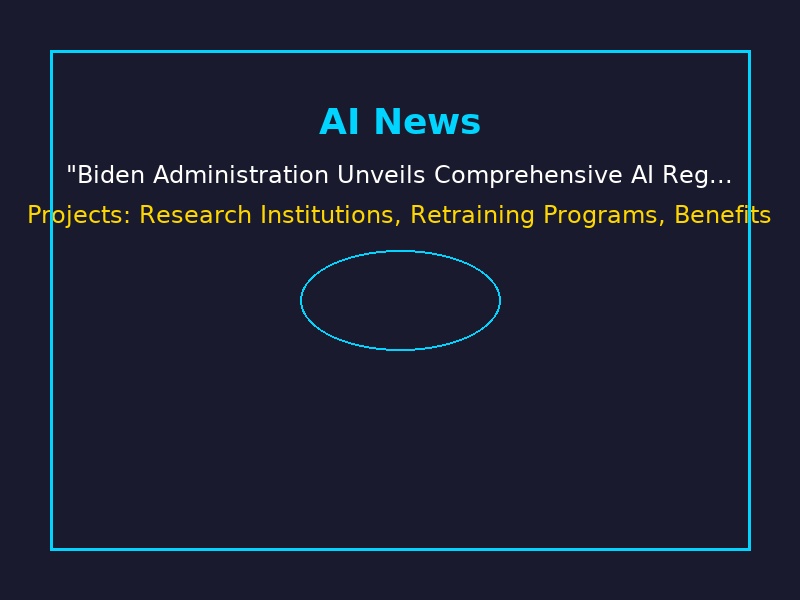
The Biden administration has announced a comprehensive framework for regulating artificial intelligence across federal agencies, marking the most significant step yet in establishing federal oversight of AI development and deployment in the United States.
Executive Order Overview
The new executive order, signed by President Biden on August 26, 2024, establishes a coordinated approach to AI governance across all federal departments and agencies. The framework addresses critical areas including:
AI Safety Standards: Mandatory safety testing and evaluation requirements
Privacy Protection: Enhanced safeguards for personal data used in AI systems
Workforce Development: Training programs for federal employees on AI technologies
International Cooperation: Guidelines for AI development collaboration with allied nations
Key Provisions
1. AI Safety and Security
The order requires federal agencies to:
- Conduct comprehensive risk assessments of AI systems before deployment
- Implement mandatory safety testing protocols
- Establish incident reporting mechanisms for AI-related failures
- Develop contingency plans for AI system malfunctions
2. Privacy and Civil Rights
Federal AI systems must now:
- Undergo bias testing to ensure fair treatment across demographic groups
- Implement robust data protection measures
- Provide transparency in decision-making processes
- Allow for human oversight and intervention capabilities
3. Workforce Impact
The administration recognizes the potential disruption AI may cause to employment:
- Retraining Programs: $500 million allocated for AI-related workforce development
- Job Transition Support: Assistance for workers displaced by AI automation
- Skills Development: Focus on AI literacy and technical training
Mathematical Framework for Risk Assessment
The new regulations introduce a quantitative approach to AI risk assessment using the following formula:
$$Risk_{AI} = \sum_{i=1}^{n} (Probability_i \times Impact_i \times Mitigation_i)$$
Where:
- $Probability_i$ represents the likelihood of a specific AI failure mode
- $Impact_i$ measures the potential consequences of such failure
- $Mitigation_i$ accounts for existing safety measures and controls
Implementation Timeline
The executive order establishes a phased implementation approach:
Phase 1 (Immediate - 30 days)
- Establishment of AI oversight committees
- Initial risk assessment requirements
- Basic safety testing protocols
Phase 2 (3-6 months)
- Full implementation of safety standards
- Training program rollout
- International coordination framework
Phase 3 (6-12 months)
- Comprehensive evaluation and refinement
- Expansion to additional AI applications
- Public feedback integration
Industry Response
The announcement has received mixed reactions from the technology sector:
Supportive Responses
- Microsoft: “We welcome clear federal guidelines that promote responsible AI development”
- Google: “Federal leadership in AI governance is essential for maintaining public trust”
- AI Safety Organizations: “This represents a significant step toward responsible AI deployment”
Concerns Raised
- Startup Community: Worries about compliance costs for smaller companies
- Research Institutions: Concerns about potential restrictions on academic AI research
- Industry Groups: Questions about international competitiveness implications
International Implications
The U.S. framework is expected to influence global AI governance:
- EU Alignment: Coordination with the European Union’s AI Act
- G7 Cooperation: Integration with international AI governance initiatives
- Standards Development: Leadership in establishing global AI safety standards
Economic Impact Analysis
The Congressional Budget Office estimates the regulatory framework will:
- Cost: $2.3 billion over 5 years for implementation
- Benefits: $15.7 billion in avoided AI-related incidents and improved efficiency
- Net Benefit: $13.4 billion over the implementation period
Congressional Response
The executive order has generated bipartisan interest in Congress:
Senate
- Democrats: Generally supportive of the comprehensive approach
- Republicans: Seeking clarification on economic impact and implementation costs
House of Representatives
- Technology Committee: Planning oversight hearings on implementation
- Appropriations Committee: Reviewing funding requirements
Public Opinion
Recent polling shows strong public support for AI regulation:
- Support for Federal AI Oversight: 78%
- Concern about AI Safety: 82%
- Trust in Government AI Management: 65%
Next Steps
The administration has outlined several immediate actions:
- Agency Coordination: Establish interagency AI governance committees
- Public Engagement: Launch public comment period on specific regulations
- International Outreach: Begin coordination with allied nations
- Implementation Planning: Develop detailed rollout schedules for each agency
Expert Commentary
Dr. Sarah Chen, AI Policy Expert at Stanford University, notes:
“This executive order represents a watershed moment in AI governance. The comprehensive approach addresses both immediate safety concerns and long-term societal implications. The mathematical framework for risk assessment is particularly innovative and could serve as a model for other nations.”
Conclusion
The Biden administration’s AI regulation framework represents a significant step toward establishing federal oversight of artificial intelligence in the United States. While implementation challenges remain, the comprehensive approach addresses critical concerns about AI safety, privacy, and workforce impact.
As the framework moves from policy to practice, ongoing collaboration between government, industry, and civil society will be essential for ensuring effective and balanced AI governance.
For more information on AI regulation and policy developments, visit our dedicated Regulation section.